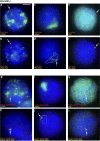Extensive meiotic asynapsis in mice antagonises meiotic silencing of unsynapsed chromatin and consequently disrupts meiotic sex chromosome inactivation
- PMID: 18663141
- PMCID: PMC2483523
- DOI: 10.1083/jcb.200710195
Extensive meiotic asynapsis in mice antagonises meiotic silencing of unsynapsed chromatin and consequently disrupts meiotic sex chromosome inactivation
Abstract
Chromosome synapsis during zygotene is a prerequisite for the timely homologous recombinational repair of meiotic DNA double-strand breaks (DSBs). Unrepaired DSBs are thought to trigger apoptosis during midpachytene of male meiosis if synapsis fails. An early pachytene response to asynapsis is meiotic silencing of unsynapsed chromatin (MSUC), which, in normal males, silences the X and Y chromosomes (meiotic sex chromosome inactivation [MSCI]). In this study, we show that MSUC occurs in Spo11-null mouse spermatocytes with extensive asynapsis but lacking meiotic DSBs. In contrast, three mutants (Dnmt3l, Msh5, and Dmc1) with high levels of asynapsis and numerous persistent unrepaired DSBs have a severely impaired MSUC response. We suggest that MSUC-related proteins, including the MSUC initiator BRCA1, are sequestered at unrepaired DSBs. All four mutants fail to silence the X and Y chromosomes (MSCI failure), which is sufficient to explain the midpachytene apoptosis. Apoptosis does not occur in mice with a single additional asynapsed chromosome with unrepaired meiotic DSBs and no disturbance of MSCI.
Figures








Similar articles
-
SPO11-independent DNA repair foci and their role in meiotic silencing.PLoS Genet. 2013 Jun;9(6):e1003538. doi: 10.1371/journal.pgen.1003538. Epub 2013 Jun 6. PLoS Genet. 2013. PMID: 23754961 Free PMC article.
-
Incomplete meiotic sex chromosome inactivation in the domestic dog.BMC Genomics. 2015 Apr 12;16(1):291. doi: 10.1186/s12864-015-1501-9. BMC Genomics. 2015. PMID: 25884295 Free PMC article.
-
Pachytene asynapsis drives meiotic sex chromosome inactivation and leads to substantial postmeiotic repression in spermatids.Dev Cell. 2006 Apr;10(4):521-9. doi: 10.1016/j.devcel.2006.02.009. Dev Cell. 2006. PMID: 16580996
-
DNA double strand break repair, chromosome synapsis and transcriptional silencing in meiosis.Epigenetics. 2010 May 16;5(4):255-66. doi: 10.4161/epi.5.4.11518. Epub 2010 May 16. Epigenetics. 2010. PMID: 20364103 Review.
-
Meiotic sex chromosome inactivation.Development. 2007 May;134(10):1823-31. doi: 10.1242/dev.000018. Epub 2007 Feb 28. Development. 2007. PMID: 17329371 Review.
Cited by
-
Phosphorylation of chromosome core components may serve as axis marks for the status of chromosomal events during mammalian meiosis.PLoS Genet. 2012 Feb;8(2):e1002485. doi: 10.1371/journal.pgen.1002485. Epub 2012 Feb 9. PLoS Genet. 2012. PMID: 22346761 Free PMC article.
-
The Initiation of Meiotic Sex Chromosome Inactivation Sequesters DNA Damage Signaling from Autosomes in Mouse Spermatogenesis.Curr Biol. 2020 Feb 3;30(3):408-420.e5. doi: 10.1016/j.cub.2019.11.064. Epub 2020 Jan 2. Curr Biol. 2020. PMID: 31902729 Free PMC article.
-
Dynamics of response to asynapsis and meiotic silencing in spermatocytes from Robertsonian translocation carriers.PLoS One. 2013 Sep 16;8(9):e75970. doi: 10.1371/journal.pone.0075970. eCollection 2013. PLoS One. 2013. PMID: 24066189 Free PMC article.
-
Aneuploidy in spermatids of Robertsonian (Rb) chromosome heterozygous mice.Chromosome Res. 2014 Dec;22(4):545-57. doi: 10.1007/s10577-014-9443-7. Epub 2014 Nov 11. Chromosome Res. 2014. PMID: 25385393 Free PMC article.
-
DNA damage response protein TOPBP1 regulates X chromosome silencing in the mammalian germ line.Proc Natl Acad Sci U S A. 2017 Nov 21;114(47):12536-12541. doi: 10.1073/pnas.1712530114. Epub 2017 Nov 7. Proc Natl Acad Sci U S A. 2017. PMID: 29114052 Free PMC article.
References
-
- Ahmed, E.A., A. van der Vaart, A. Barten, H.B. Kal, J. Chen, Z. Lou, K. Minter-Dykhouse, J. Bartkova, J. Bartek, P. de Boer, and D.G. de Rooij. 2007. Differences in DNA double strand breaks repair in male germ cell types: lessons learned from a differential expression of Mdc1 and 53BP1. DNA Repair (Amst.). 6:1243–1254. - PubMed
-
- Ashley, T., A.P. Gaeth, L.B. Creemers, A.M. Hack, and D.G. de Rooij. 2004. a. Correlation of meiotic events in testis sections and microspreads of mouse spermatocytes relative to the mid-pachytene checkpoint. Chromosoma. 113:126–136. - PubMed
-
- Ashley, T., C. Westphal, A. Plug-de Maggio, and D.G. de Rooij. 2004. b. The mammalian mid-pachytene checkpoint: meiotic arrest in spermatocytes with a mutation in Atm alone or in combination with a Trp53 (p53) or Cdkn1a (p21/cip1) mutation. Cytogenet. Genome Res. 107:256–262. - PubMed
-
- Barchi, M., S. Mahadevaiah, M. Di Giacomo, F. Baudat, D.G. de Rooij, P.S. Burgoyne, M. Jasin, and S. Keeney. 2005. Surveillance of different recombination defects in mouse spermatocytes yields distinct responses despite elimination at an identical developmental stage. Mol. Cell. Biol. 25:7203–7215. - PMC - PubMed
MeSH terms
Substances
Grants and funding
LinkOut - more resources
Full Text Sources
Molecular Biology Databases
Miscellaneous

